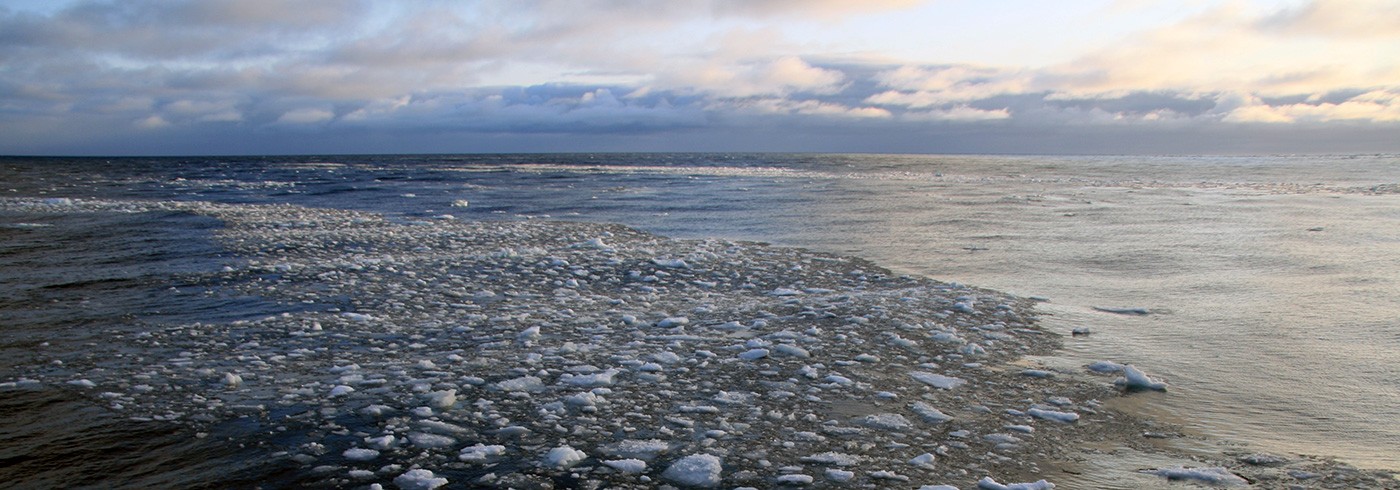International Siberian Shelf Study 2008, ISSS -08
15 August 2008 - 24 September 2008
The Jacob Smirnitskiy and the ISSS-08 was the first vessel to manage to squeeze through Vilkitskiy Strait in 2008. Photo: Jorien Vonk
The motivation for ISSS-08 was to alleviate the scarcity of observational data on transport and processing of water, sediment and carbon on the East Siberian Arctic Shelves (ESAS), particularly in terms of the effects of a changing climate. The ESAS, composed of Laptev, East Siberian and Russian part of Chukchi Sea, is the world’s largest continental shelf and at the same time the most understudied part of the Arctic Ocean.
The shelf is characterized by tundra discharge through the Lena, Indigirka and Kolyma rivers, massive coastal erosion, methane seeps from sub-sea permafrost reservoirs and shelf feeding of the Arctic halocline. The region is of particular interest from the perspective of carbon-climate couplings as it has witnessed a 4°C springtime positive temperature anomaly for 2000–2005 compared with preceding decades. A complex sampling and at-sea analysis programme was accomplished during the 50-days ISSS-08 cruise from August to September 2008 using two vessels manned by participants from 12 organizations in Russia, Sweden, UK and USA. The main vessel H/V Jacob Smirnitskiy travelled the entire length of the Siberian coast from Kirkenes, Norway through the Barents – Kara – Laptev – East Siberian Seas to Herald Canyon, Chukchi Sea and back along the outer shelf. This area extending over 4 000 km is largely unexplored, despite being one of the largest continental shelf seas in the world. A second ship sampled the Lena River and the southeastern Laptev Sea. The ISSS-08 programme was structured into eight interlinked and collaborating programmes: Benthic biology, Biogeochemistry, Geophysics/seismic, Marine chemistry, Methane, Physical oceanography, Sedimentology, and Trace elements and isotopes.

Jorien Vonk and Laura Sanchez-Garcia of the Stockholm University biogeochemistry group are sectioning one of over 100 sediment cores retrieved during the ISSS-08. Photo: Örjan Gustavsson
The fieldwork
Observations and sampling of the air made underway included micrometeorology and continuous measurements of methane and carbon dioxide, sampling of air particles (aerosols) and gas-phase organic compounds. A seawater intake system was successfully installed and demonstrated to provide clean samples for organic substances. Surface seawater samples were thus frequently collected while underway along the thousands of kilometres long route for studies of organic and inorganic carbon, including methane. A number of chemical sensors provided realtime monitoring on the composition of this surface seawater.
The ship made over 130 stops for extended at-station sampling. A multitude of samplers for probing of seawater properties and collection of seawater and sediments were deployed at these stations. A second ship detailed the Lena River and the southeastern Laptev Sea, including on-land sampling of the eroding coastal soil.
Release of methane and other at-sea observations
Significant at-sea findings included the discovery of new methane seeps and bubble plume fields in both the Laptev and East Siberian Sea, several associated with geophysical gas-chimney structures. These are notable as the conventional thought has been that the sub sea permafrost ought to act as a lid to keep the methane from escaping from the sediments. The Intergovernmental Panel on Climate Change (IPCC) points out that release of methane from the ESAS subsea permafrost does potentially constitute a substantial positive feedback to climate warming but IPCC refrains from making any assessment of this risk due to the lack of data. The ISSS-08 contributes substantial new observations on methane actually being released in this region. It is too early to make any conclusions of the quantitative magnitude of this methane release for the atmospheric methane budget. It is also not yet possible to draw any conclusions with respect to a putative connection of the releases to recent warming in the region. In fact, natural thawing mechanisms such as geothermal heat and the 7 000 years of slow warming from the overlying seawater are likely to be the dominating factors. Nevertheless, methane concentrations were often a factor of 100 above background in several large areas.
Further at-sea observation was contributed by the Physical oceanography programme, which documented Pacific inf low through Herald Canyon and remnants of salty and cold bottom waters on the shelf break.
Planned further analyses and direction of studies
At-sea analyses were also performed for the carbonate system, nutrients, dissolved organic carbon, pigments and optical properties of the organic matter. Post-cruise analysis of collected air, seawater, eroding soil and sediment material include molecular and isotopic biomarker composition as well as trace element and isotope characterizations (GEOTRACE protocol) will be carried out in shore-based laboratories. Taken together, these extensive characterizations of the collaborating ISSS-08 programmes will contribute to elucidate provenance, remobilisation of “old” terrestrial matter, the relative importance of river versus erosion sources, degradation of organic matter in seawater and sediments, off-shelf transport and variations in these processes with dynamic climate forcing.

